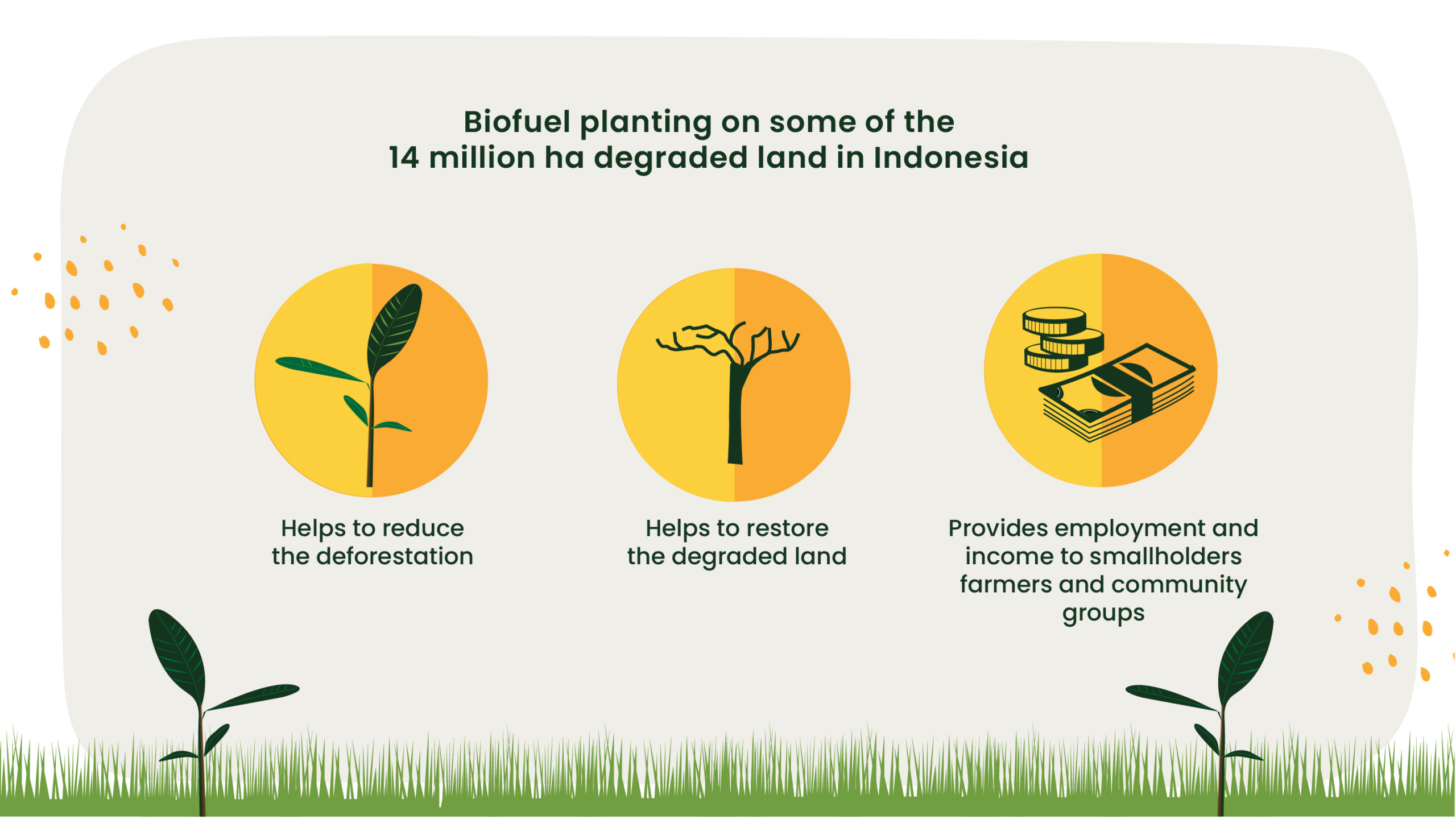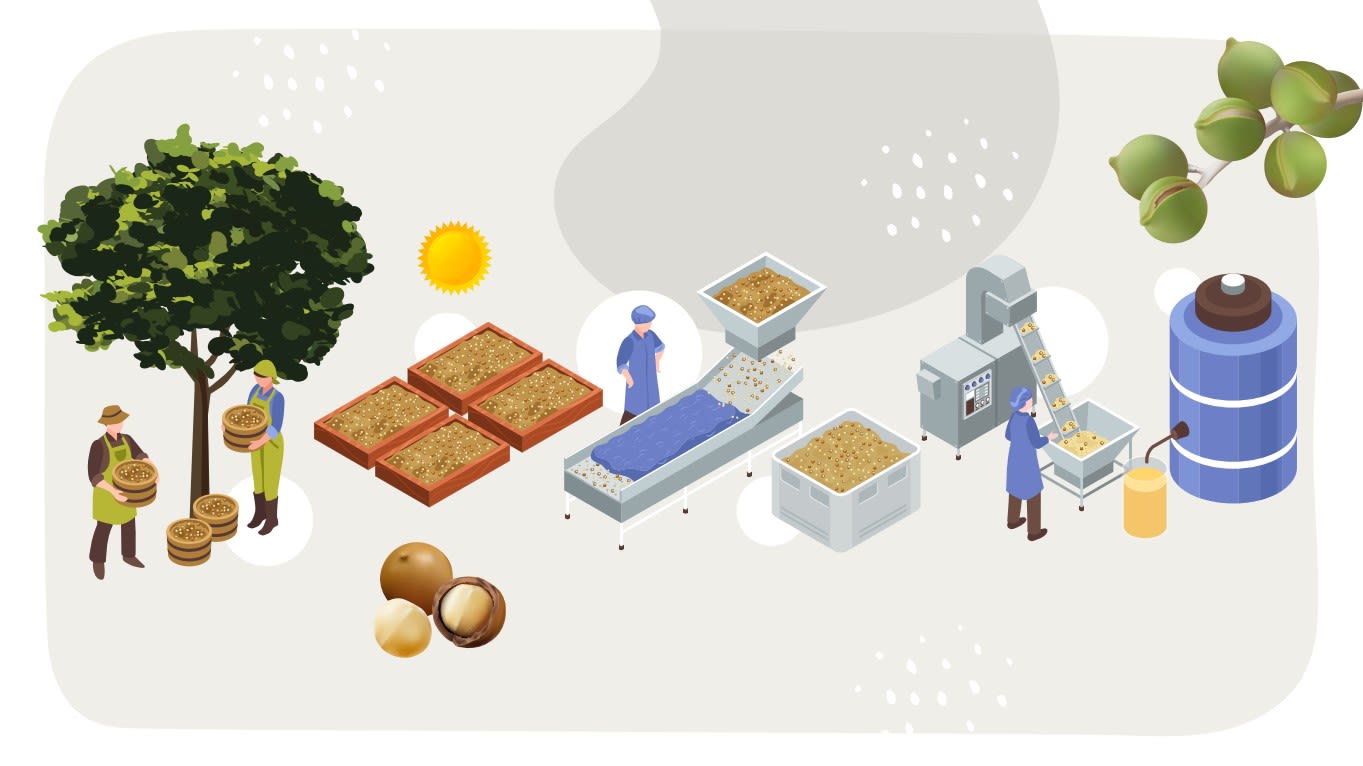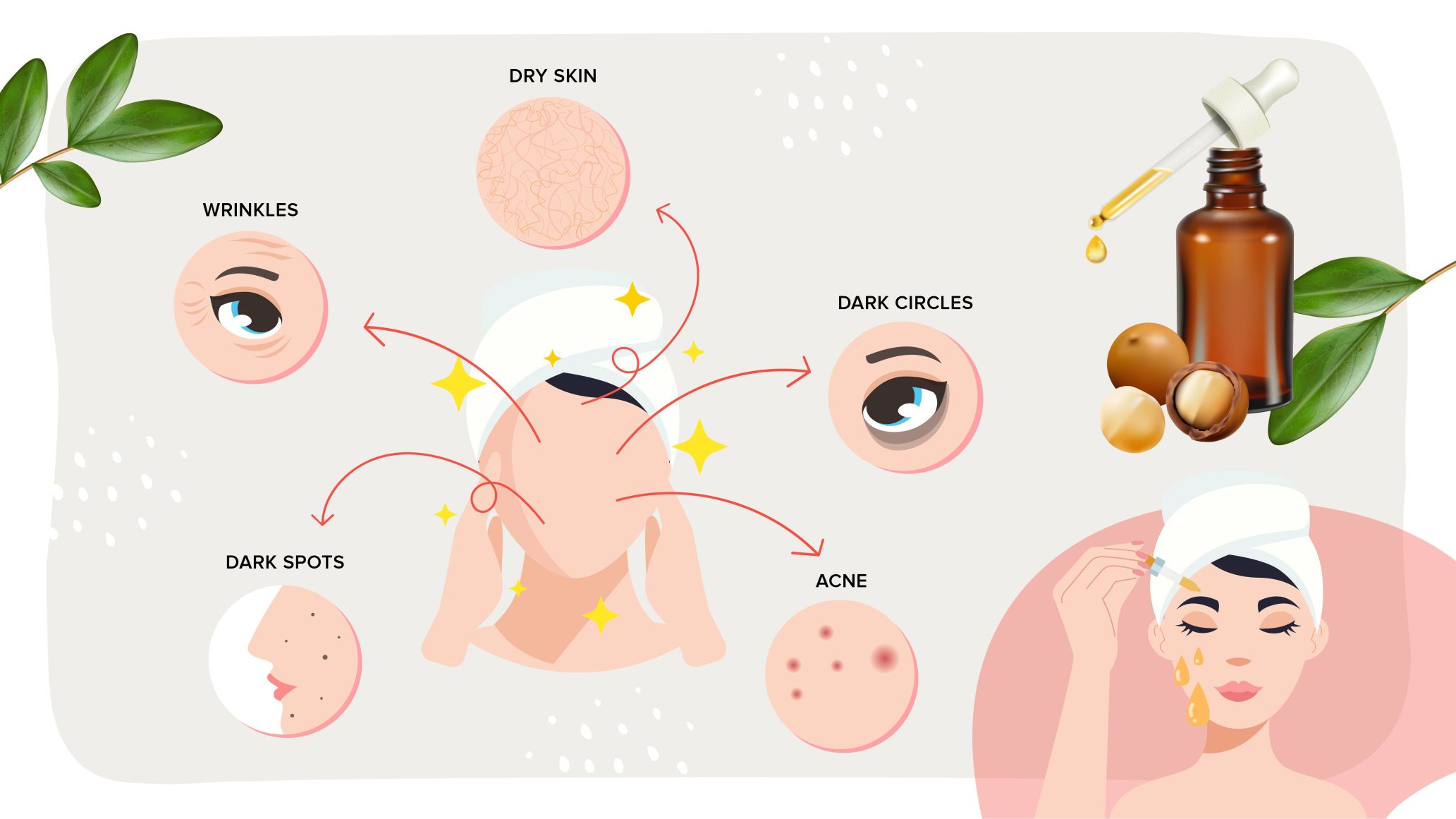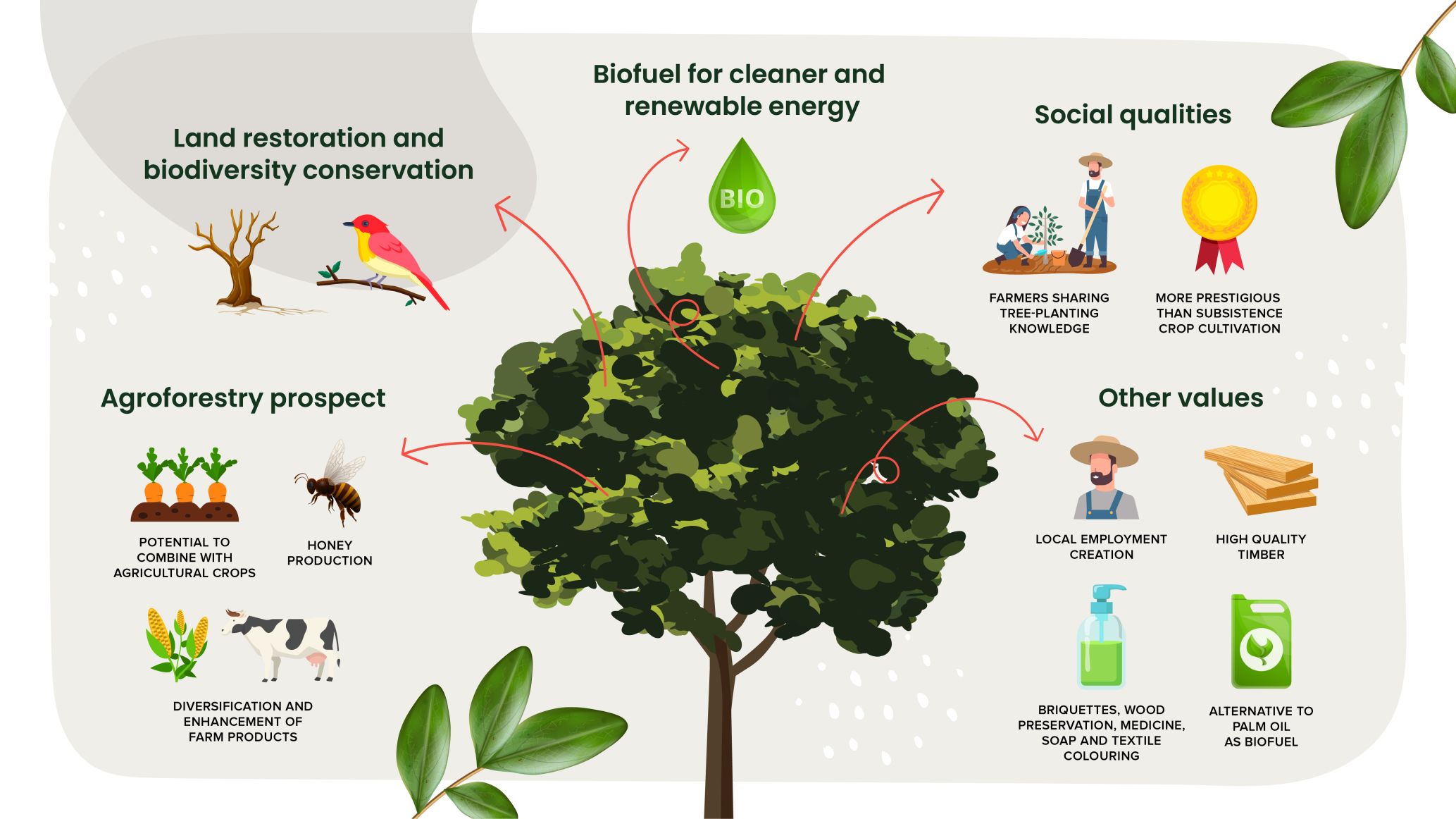We want you to share Forests News content, which is licensed under Creative Commons Attribution-NonCommercial-ShareAlike 4.0 International (CC BY-NC-SA 4.0). This means you are free to redistribute our material for non-commercial purposes. All we ask is that you give Forests News appropriate credit and link to the original Forests News content, indicate if changes were made, and distribute your contributions under the same Creative Commons license. You must notify Forests News if you repost, reprint or reuse our materials by contacting forestsnews@cifor-icraf.org.

Does a tree that can repair degraded land, heal damaged skin and provide an important source of energy sound too good to be true? Think again.
The oil from the tamanu tree, or nyamplung tree as it’s known locally on the islands of Java, Sumatra and Borneo in Indonesia, has been used for centuries as a salve for wounds and scars. Now, scientists from the Indonesian Ministry of Forestry and Environment’s Research and Development Agency (FORDA), Indonesia’s Mulawarman University, Sriwijaya University, Muhammadiyah University and the Center for International Forestry Research (CIFOR) want to find out how it heals degraded land that has been burned or mined – and simultaneously contribute to bioenergy production.

HEALING LAND
“Nyamplung has been proven to be able to grow and adapt well in burned areas with fertilizer treatment,” said Budi Leksono, an official with FORDA, in a recent ministry report titled Proven, Potential Bioenergy Plants Developed for Restoration of Degraded Land. “Even more, the exciting finding shows that the tree has begun to flower and bear fruit two years after planting and it brings in several species of birds and insects…which indicate an increase in biodiversity in the ecosystem.”
Experimental plantations that have been cultivated on degraded lands since 2017 in the provinces of Central Java and 2011 in Central and East Kalimantan are inspiring optimism. The tamanu tree is demonstrating an ability to restore and improve former forests and peatlands that have been burned or wounded by industry, overuse or deforestation.
Himlal Baral, a senior scientist in CIFOR’s Climate Change Energy and Low Carbon Development Team, said that the trial plantations are still at an early stage, but he added that the trees show “promising” survival and growth on a variety of degraded lands, including peat swamps.
One site in East Kalimantan’s Bukit Soeharto Research and Education Forest of Mulawarman University was restored to be a so-called bioenergy forest in three years, according to Sukartiningsih, the head of the Center for Reforestation Studies in the Tropical Rain Forest at Mulawarman University.
“The burned area was covered with bamboo shrubs,” she said. “The trees’ survival rate is more than 95 percent and the growth is very fast, . . . [We are] very optimistic that establishing bioenergy forests with nyamplung would accelerate the rehabilitation program on a burned site and even on an ex-coal mining site.

BIOFUEL POTENTIAL
As Sukartiningsih suggested, the Indonesian government is interested in the tamanu tree for more than one reason. The oil from the nut, which has reportedly been burned in lamps for many generations across southern Asia, has significant potential to become an important source for biofuel. This is important because the government is working toward the ambitious goal of increasing the country’s biodiesel consumption by 30 percent and bioethanol consumption by 20 per cent by 2025. The government wants to lessen the country’s greenhouse gas emissions and its reliance on foreign supplies of fossil fuel.
However, Budi Leksono has said the biofuel market as a whole had to be developed further to “create economies of scale” that would facilitate the cultivation of tamanu trees.
“The market for nyamplung oil is not really developed yet,” he said, “but we’re anticipating an energy crisis and we are preparing for the plantations of the future.

Researchers in Indonesia have determined that a single hectare of tamanu trees can yield up to 10 tons per hectare of crude nut oil every year and that there are about 3.5 million hectares of degraded land across the country suitable for the species.
In addition to fighting climate change by increasing forest cover and reducing Indonesia’s need for imported fossil fuel, the tamanu nut oil, once processed into biofuel, is also reported to produce markedly low amounts of harmful emissions.
Sukartiningsih predicted that if enough nyamplung trees were cultivated, Indonesia could quickly become a net exporter of the valuable oil.
“This plant has every prospect of being developed in Indonesia,” she said. “The growth is fast…within two years they start to flower and bear fruit. With good management they will produce a lot of fruit and produce the expected oil and other products.”

COSMETICS AND MEDICINE
Those other products that increase the tamanu’s value around the world are also derived from the oil, but they are not biofuels, they are medicinal and cosmetic lotions and balms. In Polynesia, as it happens, people are said to call the tamanu“beauty leaf,”reflecting that the oil has long been used to sooth damaged skin, heal wounds and even eliminate scars whereever the tree has grown naturally or been cultivated.
The nut oil has become a favorite ingredient used by cosmetics companies, particularly in South Korea where the oil is widely advertised and accepted to be capable of reducing wrinkles, dark spots and other skin conditions. Industry marketing claims that since the oil is rich with vitamin E, anti-inflammatories, antioxidants and fatty acids, it not only moisturizes dry skin, but actually heals it.

Research published in 2015 in the peer-reviewed PLoS One science journal set out to study if the nut oil of the calophyllum inophyllum (the tamanu’s Latin name) really worked as claimed. Scientists from several universities and institutes experimented on five samples of tamanu oil collected from Indonesia, Tahiti, Fiji and New Caledonia to determine whether the oil was toxic to skin cells, if it had the capacity to heal wounds and if it had antibacterial properties. They found several things celebrated by the beauty industry: It helped skin heal and even worked against acne.
“Using cell and bacteria cultures, we confirmed the pharmacological effects of CIO [calophyllum inophyllum oil] as a wound healing and antimicrobial agent,” the research paper concludes. “For the first time, this study provides support for traditional uses.”

LOCAL AGROFORESTRY
Baral added that the benefits of the tamanu tree, the products that come from it, do not end with oil and restored land.
“Growing tamanu trees under a climate-smart agroforestry system can support climate goals while supporting the livelihoods of rural farmers,” he said.
Indonesian farmers who are already cultivating tamanu on formerly degraded land usually intercrop it with maize, rice, cassava, soybeans and peanuts. The latter they keep to feed their families, the wood they use as lumber (it has long been highly prized for building boats), and the oil they sell.
Unfortunately, since the oil market is still limited, the farmers lament that their cash earnings are lower than hoped. Nevertheless, they report that yet another benefit of the multitalented tamanu tree is more than making up for any income shortfall.
The flowers of the tamanu tree, as the traditional cultivators have always known, are a favorite of bees. The honey they produce with the tamanu pollen is in high demand and, consequently, quite profitable.
Baral summed up the potential of the tamanu tree by pointing out that it offers broad potential as a land restoration species due to its versatility.
“It grows well under a variety of degraded land conditions, needs little care and maintenance while providing multiple potential uses, helping to fulfill national and international targets,” he said.
“There are plans afoot by both the U.N. Decade on Ecosystem Restoration (2021-2030) and the Indonesian government to restore 14 million hectares of land by 2030 and tamanu has the potential to play a big role in those efforts.”
This research was supported by the National Institute of Forest Science (NIFOS) and the Republic of Korea.
We want you to share Forests News content, which is licensed under Creative Commons Attribution-NonCommercial-ShareAlike 4.0 International (CC BY-NC-SA 4.0). This means you are free to redistribute our material for non-commercial purposes. All we ask is that you give Forests News appropriate credit and link to the original Forests News content, indicate if changes were made, and distribute your contributions under the same Creative Commons license. You must notify Forests News if you repost, reprint or reuse our materials by contacting forestsnews@cifor-icraf.org.



